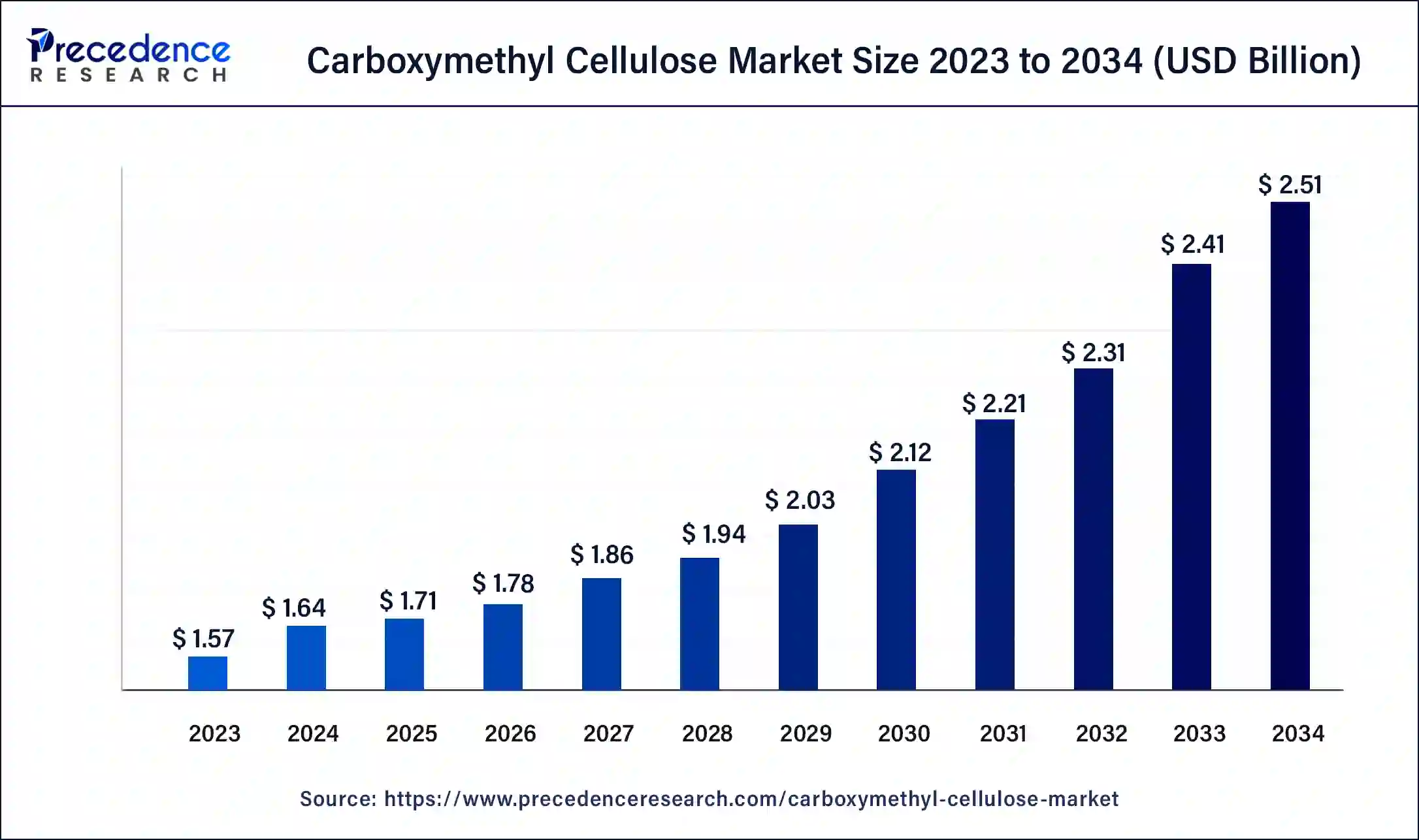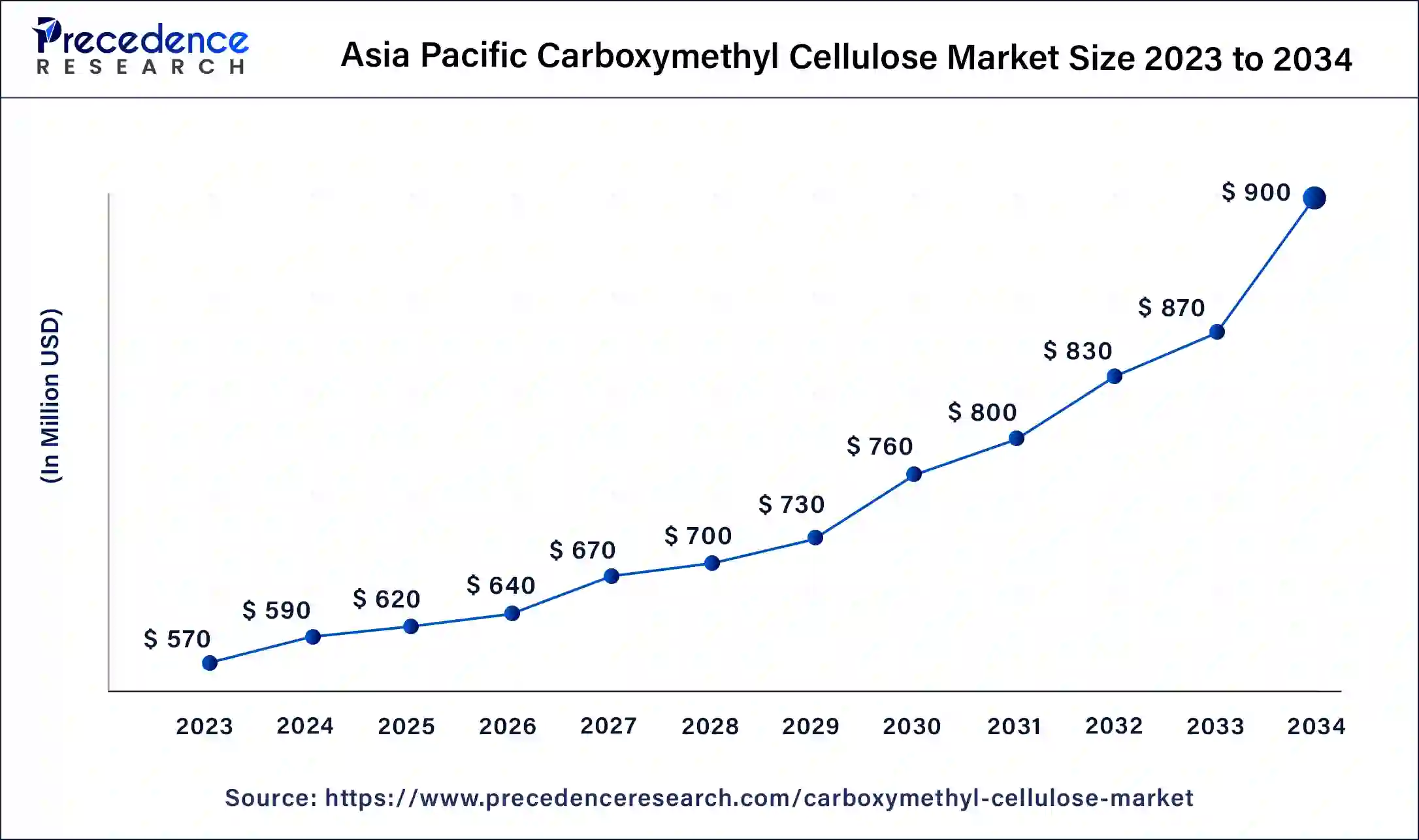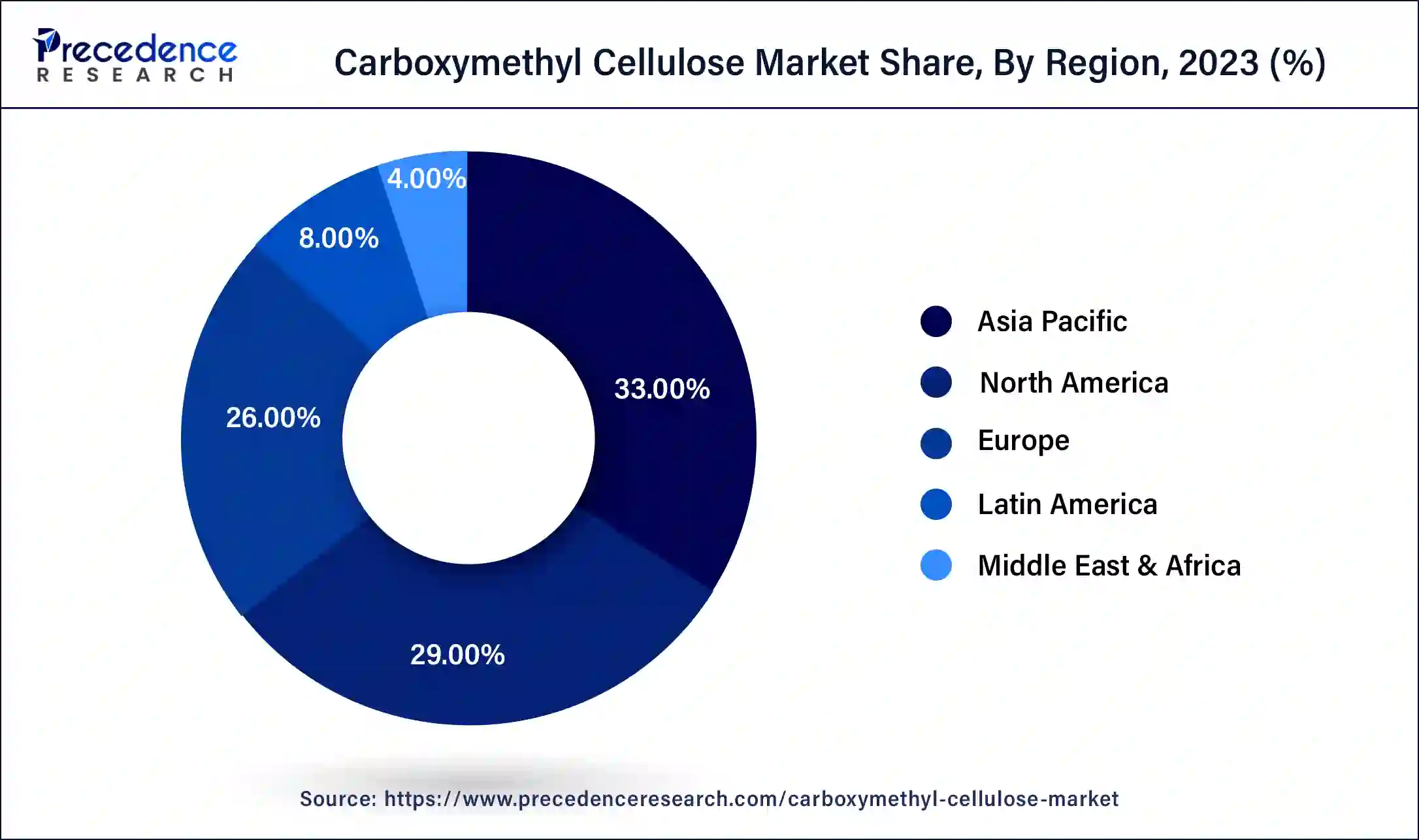Carboxymethyl Cellulose Market Size and Forecast 2025 to 2034
The global carboxymethyl cellulose market size was calculated at USD 1.64 billion in 2024 and is expected to reach around USD 2.51 billion by 2034, expanding at a CAGR of 4.35% from 2025 to 2034.

Carboxymethyl Cellulose Market Key Takeaways
- The global carboxymethyl cellulose market was valued at USD 1.64 billion in 2024.
- It is projected to reach USD 2.51 billion by 2034.
- The carboxymethyl cellulose market is expected to grow at a CAGR of 4.35% from 2025 to 2034.
- Asia-Pacific dominated the global market share of 33% in 2024.
- North America is estimated to expand the fastest CAGR between 2025 and 2034.
- By purity level, the highly purified carboxymethyl cellulose segment held the largest market share in 2024.
- By purity level, the technical grade segment is anticipated to grow at a notable CAGR between 2025 and 2034.
- By property, the thickening agent segment has generated the biggest market share in 2024.
- By property, the binder segment is expected to expand at the fastest CAGR over the projected period.
- By application, the food & beverages segment has recorded the major market share in 2024.
- By application, the oil & refining segment is expected to expand at the fastest CAGR over the projected period.
Asia Pacific Carboxymethyl Cellulose Market Size and Growth 2025 to 2034
The Asia Pacific carboxymethyl cellulose market size reached USD 590 million in 2024 and is expected to surpass around USD 900 million by 2034 at a CAGR of 5% from 2025 to 2034.

Asia-Pacific held the largest market share of 33% in 2024, due to several factors.The region's robust industrial growth, particularly in sectors such as food and beverage, pharmaceuticals, and personal care, drives the demand for carboxymethyl cellulose (CMC) as a key ingredient in various applications. Additionally, the increasing population and rising disposable incomes in countries like China and India contribute to higher consumption of CMC-based products. Furthermore, Asia-Pacific benefits from extensive CMC production facilities and a growing focus on research and development, enhancing its position in the global market.
North America is experiencing rapid growth in the carboxymethyl cellulose market due to several factors. These include the expanding food and beverage industry, where CMC is used as a thickening and stabilizing agent, and the increasing demand for natural and organic personal care products, where CMC serves as a key ingredient. Additionally, the region's thriving pharmaceutical and oil and gas sectors contribute to the market growth, driving the demand for CMC in drug formulations and drilling fluid applications. These factors collectively propel the market's upward trajectory in North America.

Meanwhile, Europe is experiencing notable growth in the carboxymethyl cellulose market due to several factors. These include the rising demand for natural and sustainable ingredients in various industries such as food and beverage, pharmaceuticals, and personal care. Additionally, stringent regulations promoting the use of CMC in food and pharmaceutical applications contribute to market expansion. Furthermore, advancements in technology and increasing investments in research and development are driving innovation, leading to the development of novel CMC formulations tailored to specific industry needs, thus fueling market growth in Europe.
The Middle East and Africa are expected to grow significantly in the carboxymethyl cellulose market during the forecast period. The growing reservoirs exploration in the Middle East and Africa is increasing the demand for carboxymethyl cellulose. Moreover, its use in the pharmaceutical sector is also increasing. Furthermore, the growing demand for sustainable and eco-friendly additives is increasing the use of plant-based carboxymethyl cellulose. Thus, this promotes the market growth.
Market Overview
Carboxymethyl cellulose (CMC) is a versatile, water-soluble polymer derived from cellulose, which is found in plants. It is commonly used in various industries for its thickening, stabilizing, and emulsifying properties. CMC is produced through the chemical modification of cellulose fibers, primarily from wood pulp or cotton. In food and beverage applications, CMC serves as a thickening agent in products like sauces, dressings, and ice cream, improving texture and stability. In pharmaceuticals, it is used as a binder in tablet formulations and as a viscosity modifier in topical creams and ointments.
Additionally, CMC finds widespread use in the production of paper, textiles, personal care products, and drilling fluids. Due to its non-toxic nature and biodegradability, CMC is considered safe for use in various consumer products. Its versatility and effectiveness make it a valuable ingredient in many industrial and commercial applications.
Carboxymethyl Cellulose Market Data and Statistics
- According to the U.S. Census Bureau, retail food and beverage store sales in the United States reached around USD 947 billion in 2022, marking a 7.6% increase from 2021. Meanwhile, StatCan reported that retail sales of food and beverage stores in Canada totaled approximately CAD 12.1 billion (USD 9.30 billion) in June 2022, up by 1% compared to January 2022.
- In January 2023, PepsiCo, an American multinational food company, disclosed plans to expand its operations in Hyderabad, India, and hire 1,200 additional employees within the next eighteen months.
- According to the National Bureau of Statistics of China, the retail trade market of cosmetics in China was approximately USD 9.18 billion in January 2022, increasing to about USD 9.76 billion in January 2023.
- As per the India Brand Equity Foundation (IBEF), India's domestic pharmaceutical market was valued at USD 42 billion in 2021, projected to reach USD 65 billion by 2024 and further expand to USD 120-130 billion by 2030. IBEF also highlighted India as the 12th largest exporter of medical goods globally, with the United States as a key market.
- According to L'Oréal's Universal Registration Document 2022, the Asia-Pacific region accounted for over 42% of the global cosmetics market in 2022, potentially boosting the carboxymethyl cellulose market.
Carboxymethyl Cellulose Market Growth Factors
- The growing demand for processed food and convenience products drives the need for carboxymethyl cellulose (CMC) as a thickening, stabilizing, and emulsifying agent in various food and beverage applications.
- The pharmaceutical sector's growth, particularly in tablet formulations and topical formulations, boosts the demand for CMC as a binder, disintegrant, and viscosity modifier in drug delivery systems and pharmaceutical formulations.
- The increasing consumer preference for natural and sustainable ingredients in personal care products fuels the demand for CMC as a thickener, stabilizer, and film-forming agent in cosmetics, skincare, and haircare products.
- The paper and textile industries utilize CMC as a sizing agent, coating additive, and viscosity modifier, driving the demand for CMC as these industries expand globally.
- In the oil and gas sector, CMC is utilized in drilling fluids to enhance viscosity, control fluid loss, and improve wellbore stability, thereby driving growth in the carboxymethyl cellulose market.
- CMC finds applications in various industries such as detergents, paints and coatings, ceramics, and construction, driven by its versatile properties and increasing awareness of its benefits across different sectors.
Market Scope
| Report Coverage | Details |
| Global Market Size by 2034 | USD 2.51 Billion |
| Global Market Size in 2025 | USD 1.71 Billion |
| Global Market Size in 2024 | USD 1.64 Billion |
| Growth Rate from 2025 to 2034 | CAGR of 4.36% |
| Largest Market | Asia Pacific |
| Base Year | 2024 |
| Forecast Period | 2025 to 2034 |
| Segments Covered | Purity Level, Property, Application, and Region |
| Regions Covered | North America, Europe, Asia-Pacific, Latin America, and Middle East & Africa |
Market Dynamics
Driver
Rising demand in personal care products
The rising demand for personal care products significantly drives the market demand for carboxymethyl cellulose (CMC). CMC serves as a crucial ingredient in various personal care items, including cosmetics, skincare products, and haircare formulations. Its versatile properties make it an ideal thickening agent, stabilizer, and film-forming agent in these products, enhancing their texture, stability, and performance. As consumers increasingly prioritize natural and sustainable ingredients in their personal care routines, CMC's biodegradable and non-toxic nature further contributes to its popularity in the industry.
Moreover, the expanding global population, coupled with growing disposable incomes, fuels the demand for personal care products across different demographics and regions. As a result, manufacturers in the personal care industry continue to seek reliable and effective ingredients like CMC to meet the evolving needs and preferences of consumers. This surge in demand for personal care products drives the consumption of CMC, propelling growth in the carboxymethyl cellulose market.
Restraint
Stringent regulations regarding food and pharmaceutical grade CMC
Stringent regulations surrounding the production and use of food and pharmaceutical grade carboxymethyl cellulose (CMC) act as a significant restraint on market demand. These regulations are designed to ensure the safety and quality of CMC used in food and pharmaceutical applications, imposing strict standards on manufacturing processes, purity levels, and allowable impurities. Compliance with these regulations often requires extensive testing, documentation, and certification, adding to the production costs and regulatory burden for manufacturers.
Furthermore, the stringent regulatory requirements may limit the availability of CMC for use in food and pharmaceutical products, as only suppliers meeting the necessary standards can supply these industries. This can lead to supply chain disruptions and higher prices for compliant CMC, deterring some manufacturers from utilizing CMC in their formulations. As a result, businesses may seek alternative thickening and stabilizing agents with less stringent regulatory requirements, impacting the overall demand for CMC in the market.
Opportunity
Development of novel formulations for CMC-based products
The development of novel formulations for carboxymethyl cellulose (CMC)-based products presents significant opportunities in the carboxymethyl cellulose market. By innovating new formulations, manufacturers can create customized CMC products tailored to specific industry needs and applications. These novel formulations may offer enhanced functionalities, improved performance, and increased versatility compared to traditional CMC products. For example, CMC-based products with modified rheological properties can cater to diverse industrial requirements, such as in paints, coatings, and adhesives.
Additionally, the development of novel formulations opens doors to new market segments and applications previously untapped by CMC.As industries seek more sustainable and eco-friendly alternatives to conventional materials, innovative CMC formulations can fulfill these demands. This expansion into new applications, coupled with the versatility and adaptability of CMC, positions it as a valuable ingredient across various industries, driving growth opportunities and expanding the market potential for CMC-based products.
Purity Level Insights
The highly purified carboxymethyl cellulose segment held the highest market share in 2024. The highly purified carboxymethyl cellulose (CMC) segment refers to CMC products that undergo rigorous purification processes to achieve high levels of purity, typically exceeding industry standards. This segment caters to industries requiring exceptionally pure CMC for applications demanding strict quality and performance criteria. Trends in this segment include increasing demand from pharmaceutical and food industries, driven by stringent regulatory requirements and the need for premium-quality ingredients in formulations. Additionally, technological advancements in purification techniques contribute to the continuous improvement of purity levels in CMC products, meeting evolving industry standards.
The technical grade segment is anticipated to witness rapid growth at a significant CAGR during the projected period in the carboxymethyl cellulose market. In the carboxymethyl cellulose (CMC) market, the technical grade segment refers to CMC products with a specified purity level suitable for industrial and technical applications. These applications typically do not require the same level of purity as food or pharmaceutical grades. Technical grade CMC finds use in various industries such as textiles, paper manufacturing, drilling fluids, and detergents. Recent trends show an increasing demand for technical grade CMC driven by its versatility, cost-effectiveness, and suitability for non-food and non-pharmaceutical industrial applications.
Property Insights
The thickening agent segment has captured the maximum market share in 2024 in the carboxymethyl cellulose market. In the carboxymethyl cellulose (CMC) market, the thickening agent segment refers to CMC products primarily used to increase the viscosity and consistency of liquids or semi-liquids. These CMC-based thickening agents find extensive applications in industries such as food and beverage, pharmaceuticals, personal care, and industrial processes. Recent trends in this segment include the development of specialized CMC formulations tailored to specific applications, as well as the demand for natural and sustainable thickening agents to meet consumer preferences for clean-label products.
The binder segment is anticipated to witness rapid growth over the projected period. In the carboxymethyl cellulose market, the binder segment refers to CMC's property as an adhesive substance used to bind together various ingredients in formulations across industries. This segment encompasses applications in pharmaceutical tablets, where CMC acts as a binder to hold the active ingredients together, and in the construction sector, where CMC is utilized in mortar and plaster formulations to improve adhesion and cohesion. The trend in the binder segment involves increasing demand for CMC due to its effectiveness as a reliable and versatile binder in diverse applications.
Application Insights
The food & beverages segment has generated the largest market share in 2024 in the carboxymethyl cellulose market. In the carboxymethyl cellulose market, the food and beverages segment refers to the use of CMC as a thickening, stabilizing, and emulsifying agent in food products and beverages. CMC enhances texture, viscosity, and shelf-life in various food applications, including sauces, dressings, dairy products, and baked goods. A notable trend in this segment is the increasing demand for natural and clean label ingredients, driving the adoption of CMC as a plant-based and eco-friendly additive in food and beverage formulations.
The oil & refining segment is anticipated to witness rapid growth over the projected period. In the carboxymethyl cellulose market, the oil and refining segment refers to the utilization of CMC in various processes within the oil and gas industry. This includes applications such as drilling fluids, where CMC is employed to control fluid viscosity, minimize fluid loss, and enhance wellbore stability. Additionally, CMC finds use in oil refining processes for its thickening and stabilizing properties. Trends in this segment include the increasing adoption of CMC in environmentally sustainable drilling practices and the development of CMC-based formulations tailored for specific oil and refining applications.
Carboxymethyl Cellulose Market Companies
- DowDuPont Inc.
- Ashland Global Holdings Inc.
- CP Kelco
- Akzo Nobel N.V.
- Nouryon
- Química Amtex S.A. de C.V.
- Lamberti S.p.A.
- Shandong Yulong Cellulose Technology Co., Ltd.
- Sinocmc Co., Ltd.
- J.M. Huber Corporation
- Daicel Corporation
- Anhui Sunhere Pharmaceutical Excipients Co., Ltd.
- Nippon Paper Industries Co., Ltd.
- SUNROSE MAC
- QINGDAO SINOCMC CHEMICAL CO., LTD.
Company revenue
- In March 2025, the full-year report for 2024 was released by Nouryon, where the revenue was reported to be $5.13 billion, excluding the negative impact of foreign currency translation. 6.5% volume growth was observed, which was due to positive contributions throughout all business units and regions. A 9.5% rise in the adjusted EBITDA, year over year to $1.16 billion, while a 220 basis point growth for adjusted EBITDA margins was noted. A total of $968 million was reported for the net cash from operating activities. While $728 million was recorded for net cash from free cash flow. This, in turn, represents a rise of 21% in the free cash flow with a stronger earnings result.
(Source: https://www.nouryon.com)
- In February 2025, a digital Report 2024 was published by AkzoNobel, highlighting profitable growth in the mixed market conditions. This report is further divided into 4 sections, namely, strategy and operations, sustainability, leadership and governance, and financial performance. The reduction of its carbon footprint by 41% highlights the progress of AkzoNobel, which aims to reduce its carbon footprint by 50% by 2030. Moreover, an adjusted EBITDA of over €1.55 billion is expected to be delivered in 2025 by the company. As for the mid-term, an adjusted EBITDA margin of above 16% and 16% and 19% of return on investment, due to industrial excellence and organic growth, will be the aim of AkzoNobel to expand profitability.
(Source: https://www.akzonobel.com)
Recent Developments
- In February 2023, Nippon Paper Industries Co., Ltd. established a manufacturing and sales subsidiary for carboxymethyl cellulose named SUNROSE MAC in Hungary. This expansion facilitated the company's supply chain growth across Europe.
- In June 2020, Nouryon completed the acquisition of the CMC business with J.M. Huber Corporation, further accelerating sustainable growth in the regional market.
- In March 2019, Nippon Paper, a global manufacturer of cellulose and paper products, announced the construction of a new manufacturing facility at the Gotsu Mill to produce carboxymethyl cellulose, a functional cellulose product.
Segments Covered in the Report
By Purity Level
- Highly Purified
- Technical Grade
- Industrial Grade
By Property
- Thickening Agent
- Stabilizer
- Binder
- Anti-repository Agent
- Lubricator
- Emulsifier
- Excipient
By Application
- Food & Beverages
- Oil & Refining
- Pharmaceutical
- Paint & Textile
- Cosmetics & Personal Care
- Paper Coating & Household Care
- Others
By Region
- North America
- Europe
- Asia-Pacific
- Latin America
- Middle East and Africa
For inquiries regarding discounts, bulk purchases, or customization requests, please contact us at sales@precedenceresearch.com
Frequently Asked Questions
Ask For Sample
No cookie-cutter, only authentic analysis – take the 1st step to become a Precedence Research client
 sales@precedenceresearch.com
sales@precedenceresearch.com
 +1 804-441-9344
+1 804-441-9344